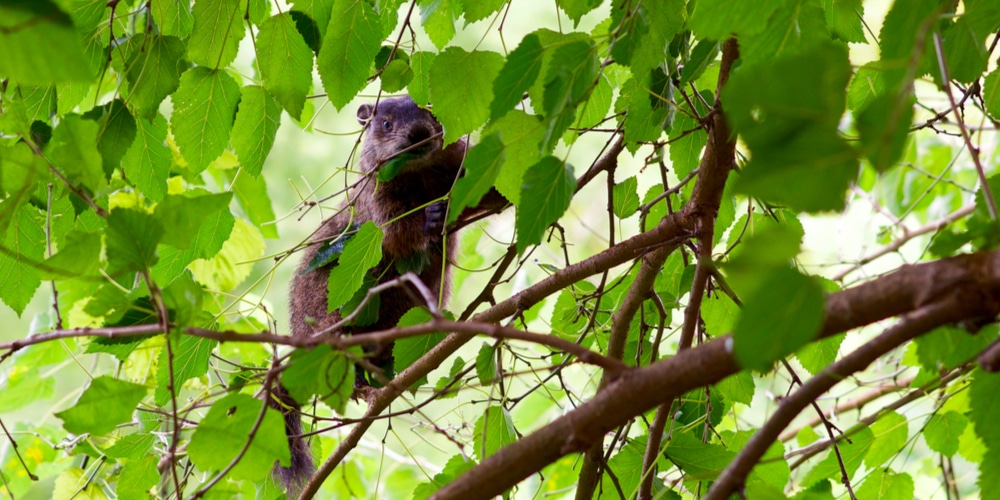Groundhogs have an interesting life. They are chunky, muscular little marmots known for their feast-or-famine lifestyle. Precisely, groundhogs gorge themselves all summer to prepare to hibernate in winter, where they can hibernate for up to 5 months, making for one of the true hibernating animals.
Typically, groundhogs are seen on the ground and live in underground burrows.
However, because they frequent areas where woodlands meet open spaces – fields, streams, roads, etc. – it is not uncommon to hear curious individuals asking whether or not these rodents can climb trees.
Can groundhogs climb trees?

Definitely, YES. In fact, groundhogs are not only capable of climbing trees but are quite good at it. Although this is least expected for an animal with “Ground” in its name and unimaginable for a “hog,” it happens with groundhogs. Read on to learn more about groundhogs.
About Groundhogs
Groundhogs (Marmota monax) are also known as woodchucks and many other nicknames. They have dark gray hairs, a short tail, and long front legs.
Considered the most solitary of the marmot species, groundhogs are stocky and compact rodents primarily found in North America. They can be found in a range of habitats but mainly live in burrows, which average about 14 inches deep but can be up to 66 feet long.
Their burrows usually have multiple exits (normally 4) around the main entrance, where individuals keep to themselves, only to seek one another when the time to mate comes.
As for climbing trees, groundhogs are considered excellent climbers despite their heavy-bodied appearance. However, they only climb trees when necessary, with the main reason for climbing trees being to escape large predators.
Groundhogs have strong and sharp claws that allow them to climb trees to escape large predators. Although they can climb most trees, they are an intelligent species and tend to choose trees with softer barks so they can escape quicker. They can also climb natural terrain and some artificial structures.
When panicked, groundhogs use a high-pitched whistle to warn the rest of the colony.
Importantly, groundhogs do not cut down trees like their cousin, the American beaver.
It may be worth noting that groundhogs are adept swimmers.
How and why do groundhogs climb trees?
Despite their heavy physical appearance, groundhogs are adept climbers and have an easier time scaling up trees. They have thick claws that penetrate tree barks efficiently, helping them climb up faster.
Their weight is also evenly distributed, making it easy for them to pull their weight as they go up. But why would any groundhog climb a tree?
Here are potential reasons why groundhogs climb trees and other terrains:
Food: Groundhogs have a prodigious appetite. Although they are fond of vegetables, they can feed on fruits and foliage of other plants. They will climb a tree to reach some tempting fruits, tree foliage, and nuts. They also prey on insects like grasshoppers and June bugs and sometimes climb trees very fast to chase them.
Keep themselves safe: Groundhogs normally live and hide in underground burrows. However, some groundhogs will hibernate on trees during winter to avoid predators like coyotes or foxes that may dig into their tunnels.
Protection: Groundhogs may climb trees to escape large predators when threatened while away from their homes. Trees provide an easily accessible refuge for groundhogs when threatened by predators that cannot climb trees. They may also climb trees to watch if there are encroaching predators.
Keep a lookout: Climbing on top of trees allows groundhogs to watch the ground below, letting them notice predators when still far. This helps them plan the next move and escape injury. Because most of their predators, like coyotes, are large animals that cannot climb trees, sitting in trees can give them peace and unmatched safety.
Groundhogs are a favorite prey for many large animals. Some predators that pose a serious threat to these rodents are coyotes, foxes, and bobcats.
Because predators like bobcats are adept climbers, groundhogs often prefer to hide deep in the soil or holes in trees where bobcats and other predators cannot fit inside.
Can groundhogs climb trees: Final thoughts
Groundhogs are capable of climbing trees and are, in fact, excellent at it. Even so, they will only get up there when necessary.
In most cases, they will stay on the ground or underground during winter.
Related Article: Do Chipmunks Climb Trees?
